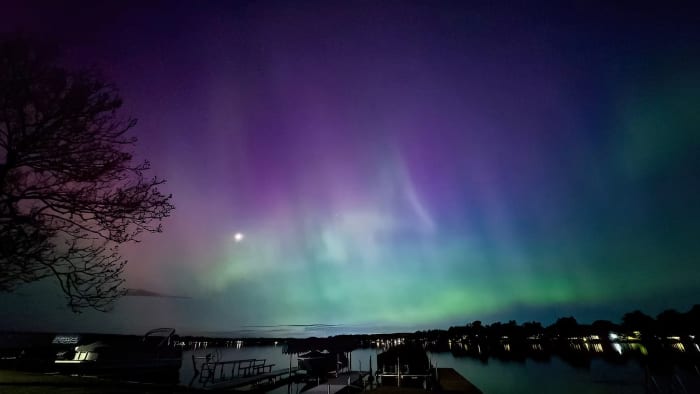
All of Michigan could see Northern Lights this weekend: What to know
Posted on 10/05/2024

All of Michigan will have a chance to see Northern Lights this weekend.
Space weather forecasters have issued a G3 geomagnetic storm watch for Oct. 4-6, due to a pair of coronal mass ejections, which means the Aurora Borealis could stretch south into Michigan on Friday night and into the weekend. The better chance is Saturday night.
Here’s a look at the projected forecast: The red line shows how far south the aurora could stretch. As you can see, the red line reaches through all of Michigan and the Great Lakes region.
Northern Lights viewing tips:
Look north! The aurora will likely be on the horizon but higher in the sky the further north you are.
Dim the lights: Find an area with less light pollution for your best chance.
Catch a photo of the lights? Post it to Local 4′s MIPics here and we’ll show them on TV.
A geomagnetic storm is a major disturbance of Earth’s magnetosphere that occurs when there is a very efficient exchange of energy from the solar wind into the space environment surrounding Earth. These storms result from variations in the solar wind that produces major changes in the currents, plasmas, and fields in Earth’s magnetosphere.
The solar wind conditions that are effective for creating geomagnetic storms are sustained (for several to many hours) periods of high-speed solar wind, and most importantly, a southward directed solar wind magnetic field (opposite the direction of Earth’s field) at the dayside of the magnetosphere. This condition is effective for transferring energy from the solar wind into Earth’s magnetosphere.
What are the Northern Lights?
The bright dancing lights of the aurora are actually collisions between electrically charged particles from the sun that enter the earth’s atmosphere. The lights are seen above the magnetic poles of the northern and southern hemispheres.
They are known as ‘Aurora borealis’ in the north and ‘Aurora Australis’ in the south.. Auroral displays appear in many colors although pale green and pink are the most common. Shades of red, yellow, green, blue, and violet have been reported.
The lights appear in many forms from patches or scattered clouds of light to streamers, arcs, rippling curtains or shooting rays that light up the sky with an eerie glow.
Space weather forecasters have issued a G3 geomagnetic storm watch for Oct. 4-6, due to a pair of coronal mass ejections, which means the Aurora Borealis could stretch south into Michigan on Friday night and into the weekend. The better chance is Saturday night.
Here’s a look at the projected forecast: The red line shows how far south the aurora could stretch. As you can see, the red line reaches through all of Michigan and the Great Lakes region.
Northern Lights viewing tips:
Look north! The aurora will likely be on the horizon but higher in the sky the further north you are.
Dim the lights: Find an area with less light pollution for your best chance.
Catch a photo of the lights? Post it to Local 4′s MIPics here and we’ll show them on TV.
A geomagnetic storm is a major disturbance of Earth’s magnetosphere that occurs when there is a very efficient exchange of energy from the solar wind into the space environment surrounding Earth. These storms result from variations in the solar wind that produces major changes in the currents, plasmas, and fields in Earth’s magnetosphere.
The solar wind conditions that are effective for creating geomagnetic storms are sustained (for several to many hours) periods of high-speed solar wind, and most importantly, a southward directed solar wind magnetic field (opposite the direction of Earth’s field) at the dayside of the magnetosphere. This condition is effective for transferring energy from the solar wind into Earth’s magnetosphere.
What are the Northern Lights?
The bright dancing lights of the aurora are actually collisions between electrically charged particles from the sun that enter the earth’s atmosphere. The lights are seen above the magnetic poles of the northern and southern hemispheres.
They are known as ‘Aurora borealis’ in the north and ‘Aurora Australis’ in the south.. Auroral displays appear in many colors although pale green and pink are the most common. Shades of red, yellow, green, blue, and violet have been reported.
The lights appear in many forms from patches or scattered clouds of light to streamers, arcs, rippling curtains or shooting rays that light up the sky with an eerie glow.
Comments( 0 )
0 0 0
0 0 2

:quality(70)/cloudfront-us-east-1.images.arcpublishing.com/adn/JF6FH7DLYVBLZMKLMUUM52A2CI.JPG)




















